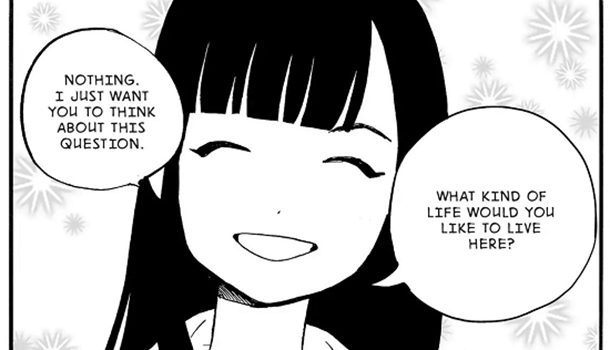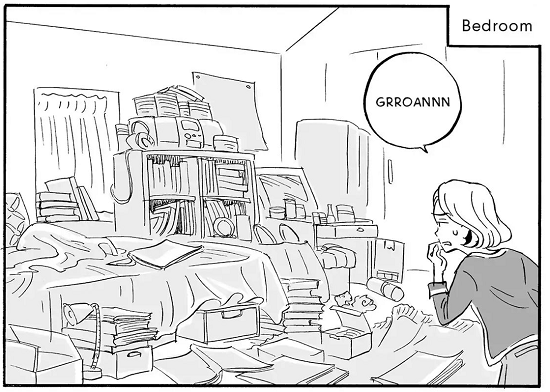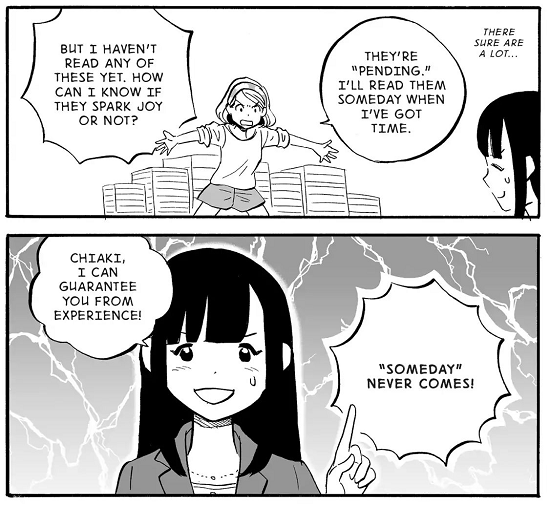
Written by Robert Frazer on 31 Aug 2020
Distributor Ten Speed Press / Bluebird • Author/Artist Marie Kondo / yuko uramoto • Price £13.99
Oh boy oh boy oh boy oh boy it’s time for dddrrrrrrraaaaaaaaammmmmaaaaa!
Many of you may not have heard of Marie Kondo, but as someone who sells wellness packages as part of my job I’ve encountered her handiwork a few times. In the self-help industry, Marie Kondo’s what fabulously expensive consultants these days call a “disruptor”. Styled as the “Queen of Clean”, Marie Kondo is a makeover icon said to embody the classically Japanese aesthetic of tasteful minimalism (even though she’s actually Korean by birth, Japan has become her adoptive country), aiming to relieve your life of all the suffocating kipple that builds up around us. Her lifestyle guide The Life-Changing Magic of Tidying Up is a multi-million bestseller and its great success was something she built on last year with a heavy push into the English-language market, including a Netflix reality show where she taught hoarding American families how to sweep out all of the psychologically burdensome junk from their homes.
After any push comes a backlash. The business of relaxation is a vicious one and the wagons were quickly circled against the invader. There was a raft of ‘gotcha!’ articles sneering that a woman whose brand was getting rid of products was still selling her own merchandise on an online store; lots of op-ed columnists defensively grumbling that they liked cluttered-up homeliness, thank you very much; others more philosophically said that the trademarked “Konmari” method was part of the problem not the solution, and that for all her supposed un-materialistic nature she was actually contributing to a consumerist ‘disposal culture’ and that the solution to clutter was to buy better, not throw out more. Then there was the backlash to the backlash, as ‘Konverts’ denounced anyone criticising their guru as prejudiced and then round and round and round it dizzyingly went. If it proved anything it was that you don’t need an excess of possessions to generate a lot of angst, disturbance and heat.
I like to imagine that I’m of the fairly settled sort who is conscious of his own inadequacies and is keeping up the interest payments on the wages of his sins; I’ve never reserved much patience for “self-help”. I’ve actually had this manga for over a year, and it was really only an impulse buy while browsing in Waterstones for the simple curio value of a non-fiction manga more than anything else. 2020 however has been a year of flux and uncertainty for all of us: circumstances have afforded more time than I had scheduled for personal reflection, let us say. I thus dug The Life-Changing Manga of Tidying Up out from where I’d stashed it – in a drawer under the bed, underneath a half-a-dozen other books which are now strewn over one half of my bed (along with empty Amazon packaging, a copy of Retro Gamer from three months ago and a bundle of unironed clothes) while I curl up with Konmari’s official manga in the other half to see if it’s able to offer any insight on the way forward.
If you’re wondering why two publishers are listed above, my own ‘Ten Speed Press’ copy of this manga is a few years old but it was apparently republished under the Pan Macmillan lifestyle label ‘Bluebird’ late in 2019. Judging from previews the two different versions seems identical in everything except the label, so whichever edition you buy not missing out on anything either way. So what does it actually say?

The Life-Changing Manga of Tidying Up applies Marie Kondo’s cleaning-up principles to a model scenario. We follow Chiaki Suzuki, a yuppie twentysomething in the big city. All that go-getting cosmopolitan independence has an upshot though – Chiaki’s such a career woman that her apartment is an utter pigsty. All her belongings are just a constant mess of being shifted from pile to pile, and coming home at the end of the day is only a source of even more stress when she spends half the night trying to find the latest item she’s lost amidst the snowdrifts of junk and laundry. Things come to a head when Chiaki thinks that she’s caught the eye of the cute guy next door only to find out that he’s just knocking not because he’s been beguiled by her beauty but because he’s complaining about the smell of the trash on the balcony that she forgot to leave for the dustman. Chiaki is humiliated by his disgust for her slovenly home life and she experiences what alcoholics call a moment of clarity. It’s time to tidy up! But the task is so huge, where do you even start? Then Konmari enters the picture, descending in like Mary Poppins to show a desperate Chiaki how the magic of tidying up is not just about making cleaning easier but can alter your perspective on what you want to get out of the world and give you a whole new lease on life.
The Life-Changing Manga of Tidying Up is certainly designed for a more mainstream audience than typical manga fans – it’s one of the rare manga nowadays to be presented ‘flipped’, reading left-to-right to be more friendly to ordinary English readers (something I haven’t seen since Ichi-F ). It doesn’t affect the legibility of the story in any way - other than the small and inessential detail of the plan of Chiaki’s apartment in the introduction being backwards to how it’s actually shown in the manga panels it doesn’t noticeably affect the art. If you’ve never read comics before there are also more direct text summaries of the key points at the end of each chapter, so it remains an accessible book. I doubt I’d ever buy a self-help book for anyone else (can such a gift be anything other than a passive-aggressive criticism of the recipient’s behaviour?) but if you were getting it for yourself it doesn’t exclude the more casual reader.
The artwork is also accessible – straightforward illustrations which may not have much style to them but remain clear and readable while also still having a thin sketchiness so that they don’t feel like you’re reading an instruction manual and come across as light-hearted. On contemplation, I actually think that the comic/manga format is actually very well-suited to this sort of content as well. A legitimate criticism of the genre of self-help (and, let’s be honest, more academic philosophy than tenured professors would care to admit) is that it is smothered in padding. The actual effective guidance can often be fired out with a single clip of bullet-points, but the help is stretched out with repetition and wide-spaced text to fill out a coffee-table hardback. A manga doesn’t have this problem – that there are fewer words is not a noticeable gap but a complementary feature, as the space can instead be filled with the art, and so it feels more substantial. Visualisation via the art is also a practical asset for actually demonstrating the changes promised by the ‘Konmari’ method – and while the set-up of Chiaki gradually bringing her neighbour back around again as she undergoes her tidying-up journeys, successive encounters between Kondo’s lessons demonstrating how the cleaning-up also improves Chiaki’s personal presentation and psychology, might seem to be a fictional propaganda you can’t deny that it works well to pull you in and sell you on the principles.
Do those principles actually amount to anything? I was actually very impressed by Kondo’s first lesson – before a single crisp packet is discarded, she tells Chiaki to first think about the sort of lifestyle she actually wants at home. This is something that strongly resonates with my own experience: when dealing with customer complaints what I always impress upon my team members is getting to the root cause of the issue – don’t just apologise and chuck compensation at the problem, as that’s treating the symptoms and not the disease. What is actually making the customer angry, and what can you change to relieve that source of distress, get them back to actually enjoying their holiday, and making sure they go home happy? Kondo’s foundation of getting Chiaki to first consider what will create a happy home underneath all the junk is a key focusing lens that I’d happily agree with.
The core of Kondo’s cleaning-up method – widely cited and sometimes mocked – is to see what among your belonging “sparks joy”. When knowing what to throw away and knowing what to keep (as a certain card sharp once said), you have to lay out your things, actually physically handle them and see if you feel that emotional connection to them – whether they “spark joy”. It does sound a little self-consciously cringeworthy to say it out loud, but the book does show that it’s a highly adaptable idea. It’s not all just vague woolly platitudes either, and Kondo does get down to brass tacks and bring a number of specific practical tasks as well. Her idea of cleaning by category, not room – so bringing all your things into one place even if you have to carry them in from all over the house – sounds counter-intuitive but she make a fair case for the reasons behind it. Furthermore, as someone who is allergic to ironing and has a bad habit of just letting washing hang on the line, her chapter on crease-free clothes folding is honestly something I’ve started following myself!

There will be some things in the book that manga readers in particular will find hard to swallow – we cherish our collections, so Kondo’s cheerful dismissal of entire bookcases of old volumes is likely to incite outright mutiny (her casual attitude to discarding books was also a major fallout from her Netflix show too, provoking a host of downright apocalyptic articles denouncing her as some sort of culture-destroying barbarian Hun). I also think that she overeggs the pudding a bit when it comes to throwing out clothes – you will still need those jumpers come winter-time. The specificity of her scenario for this manga's storyline also does tacitly highlight an unvoiced difficulty that her method suits an independent chic singleton who doesn't have to share but is less achievable for a busy family home: in the scenario Kondo is also lucky to have a very obedient pupil in Chiaki, for as reality-show subjects go Kondo never has to put too much effort into persuading an uncooperative client like Gordon Ramsay being reduced to shouting that it's "f**kin' raw!" Nonetheless, I can agree that Kondo has provided a real concrete structure for her ideas.
There is still a fair amount of set-dressing on top of that: Kondo does have several quite unscientific rituals when cleaning, such as clapping her hands to ‘wake up’ books or in another section where she says that she is performing lay-on-hands like a faith healer, but if you are an avowedly secular sort who has no patience for the unobserved world then this spiritualism should still be tolerably mild. Writing elsewhere outside this manga, Kondo calls her rituals part of Shintoism, and while I don’t know enough about Shinto to judge whether she’s properly honouring Japan’s ancient animism it’s at least some small relief that she’s not invoking Californian guff like crystals or triangles.
That last point is interesting because to be honest, I sat down to this review of The Life-Changing Manga of Tidying Up fully expecting to trash it: I was looking forward to treating myself to an entertaining afternoon gleefully putting down a load of vacuous and credulous New Age woo. I mean, seriously, Marie Kondo calls herself in this book a “tidying consultant”? It sounds like one of those celebrity non-jobs that only exist in Malibu or Middle Manhattan to sponge off helpless Hollywood actors and somnolent heiresses who need five P.A.s, two yoga instructors and a therapist to tie their shoelaces in the morning. I was also put on guard about the level of publicity surrounding Marie Kondo – anyone this prominent must have more marketing behind them than substance, surely? One of the dramas brought up at the start of the review did stick – Kondo is a bit guilty of overpriced celebrity merchandise, as £13.99 is a lot to pay for a small thin manga volume... but Kondo’s not nearly as bad as Gwyneth Paltrow’s ‘goop’ so these things must be seen in perspective. Despite those negative expectations though, it’s credit to The Life-Changing Manga of Tidying Up that it won me over with considered advice. “Life-Changing” is a bit extreme but I still found myself genuinely ruminating on the novel approaches that Marie Kondo had to offer.

Robert's life is one regularly on the move, but be it up hill or down dale giant robots and cute girls are a constant comfort - limited only by how many manga you can stuff into a bursting rucksack.
posted by Eoghan O'Connell on 25 Nov 2025
posted by Ross Locksley on 06 Nov 2025
posted by Eoghan O'Connell on 05 Nov 2025
posted by Ross Locksley on 21 Oct 2025
posted by Eoghan O'Connell on 18 Oct 2025
posted by Ross Locksley on 26 Sep 2025
posted by Eoghan O'Connell on 23 Sep 2025
posted by Ross Locksley on 16 Sep 2025